Content
- What is it, definition
- Manifestations
- Specific
- Non-specific
- Irritants
- Adequate
- Inadequate
- Basic properties
- Indicators
- How is it measured
- Lability video
In physiology lability is usually called functional mobility, the intensity of elementary cycles of excitation in muscle and nervous tissue. For the first time this property of a set of cells was described by N. E. Vvedensky in 1892 The Russian, Soviet physiologist was able to determine that the intensity of the process of excitation in the tissues cannot be constant. This means that each living cell is able to respond to stimulation (stimulus) with a limited number of waves.
For example, the striated muscle can reproduce a maximum of 250 impulses per page, the processes of neurocytes - up to 1000, the myoneural synapse - up to 125. Lability is variable, as it can vary within a fairly wide range. The functional mobility of tissues is controlled by the autonomic nervous system, which also maintains the rhythm and stability of physiological processes that affect the general condition of a person.
What is it, definition
Lability in physiology is the main property of a tissue that determines its functional state.
The reaction to prolonged arousal can be expressed in 1 of 3 available ways:
- Transformation of the original rhythm towards lower frequencies. Most often, the answer is received only for every 3 impulses.
- The answer to every impulse.
- Termination of response.
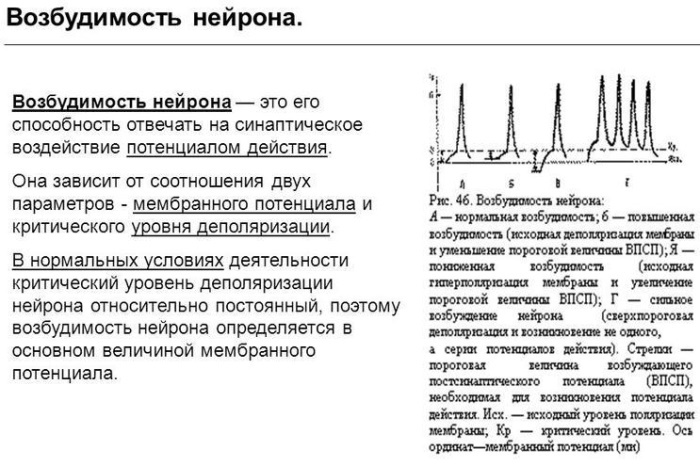
Each cell of the body has an individual rhythm. The faster the tissue can respond to stimuli, the higher its lability will be. In this case, it is necessary to take into account the recovery time of the tissue. For example, if the response is fast but it takes a long time to recover, then the resulting lability score will be relatively low.
In the absence of serious diseases in a person, lability can increase based on the metabolic rate. This is due to the fact that metabolism forces all body systems to accelerate the rhythm of work.
Lability of tissues will be significantly higher while running than when reading a book. At the same time, increased indicators always remain after the cessation of vigorous activity, but not for long. These reactions are directly related to the assimilation of a rhythm that best suits physical needs and current environmental conditions.
The control of physiological lability is extremely important in the presence of pathologies of a psychological nature. Many pathological conditions develop not against the background of mental abnormalities or strong emotional upheavals, but due to the development of physiological disorders.
For example, the right physiological effects on the body can overcome sleep problems, thereby increasing alertness and reducing irritability. Otherwise, medical treatment without taking into account physiological parameters would be ineffective.
The degree of excitability of a living cell is determined by 2 main indicators:
- For the minimum time of exposure to a stimulus with a certain intensity.
- By the lowest threshold intensity of the impact of factors of the external, internal environment.
The lability of tissues changes based on their current state and the conditions created.
Manifestations
Excitable cells are responsible for the perception of incoming signals and the formation of an appropriate response to the action of various stimuli. But the most susceptible to them are muscle fibers and neurons. But the number of neuroglia in the brain significantly exceeds the number of neurons, but they are not endowed with excitability, which, as a result of the natural development of living nature, was formed from the property of irritability inherent in all cells.
Of great importance in physiology is the threshold of irritability, which indicates the minimum force of the influence of external (internal) factors that provoke the formation of the corresponding response. Any excitation is characterized by the occurrence of nonspecific and specific changes affecting the totality of cells and intercellular substance.
Specific
Neurons are characterized by the generation of an action potential. The transmission of the excitation wave over long distances occurs without a decrease in the maximum value of the action potential, which in 98% of cases is 6 times higher than the threshold value of depolarization.
The specific response of muscle fibers to an influencing stimulus is generation, transmission of an impulse and subsequent contraction. The main indicator of the appearance of an excitation wave is the formation of an action potential, which implies an inversion of the sign of the charge.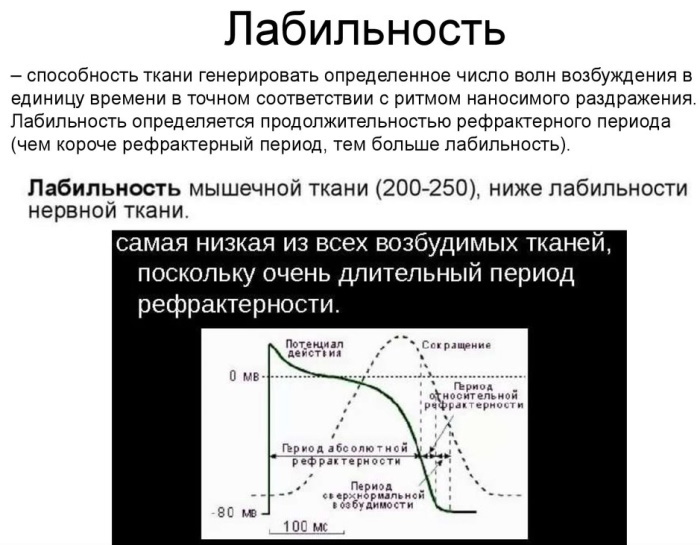
In a relatively short period of time, the membranes acquire a negative charge, which was previously positive and remained in a quiescent state. If the cell does not respond to stimuli, then under the influence of external or internal factors, only the numerical equality can change voltage between the points where the unit charge is located within the elastic molecular structure, but the permutation of the charge sign does not happens.
Non-specific
In physiology, it is customary to refer to the change in the final permeability of the elastic molecular structure for different substances, as well as an improvement in metabolism, a significant increase in the absorption of oxygen by cells and the subsequent release of a binary carbon compound, oxygen.
Additionally, there is a decrease in the level of acidity and an increase in cell temperature. All these characteristics are in many ways similar to the response of non-excitable cells to the action of factors of the external (internal) environment.
The generation of an action potential can occur due to the influence of signals that come from the external environment, microenvironment cells or automatically, when it comes to changing the permeability of the elastic molecular structure consisting of proteins and lipids. It is believed that such cells are endowed with automation.
Spontaneous activity without the influence of external factors is characteristic of smooth myocytes of the walls of blood vessels, as well as the cells of the pacemaker. Based on the degree of tissue development and the intensity of the influence of factors of the external (internal) environment in the human body, local or impulsive excitation can occur.
Irritants
Lability indicates the total amount of action potentials generated by a set of cells and intercellular substance in 1 s. In the process of active depolarization and at the initial stage of repolarization, the cell remains non-excitable. In the scientific community, this phenomenon is called absolute refractoriness. In physiology, stimuli are those factors that affect excitable structures. The classification is carried out on a biological basis.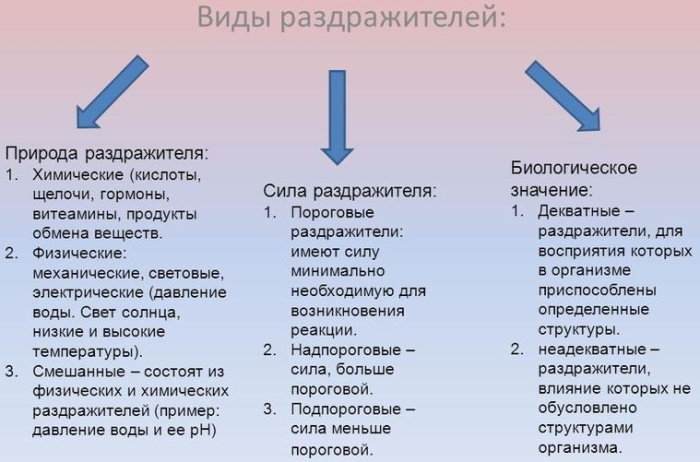
| Types of stimuli | |
| Category | Representatives |
| Physical | Electric current, high / low temperature, static, vibration and shock loads, linear acceleration and acoustic noise |
| Chemical | Alkalis, biologically active compounds, detergents, solvents, neurotransmitters, peptide molecules |
| Physicochemical | Gauge hydrostatic pressure, pH |
Taking into account the intensity of the impact, stimuli can be suprathreshold, threshold, and subthreshold strength. Additionally, it is customary to distinguish external as well as internal factors of influence on cells. In the first case, the speech concerns various changes in the environment. For example, the impact of a mechanical or chemical type, vibrations of waves in space, which are perceived by the senses.
Internal stimuli imply a change in the physicochemical characteristics and composition of fluids (blood, lymph, tissue liquid), interconnected and participating in metabolism, as well as fluctuations in the intensity of filling of tubular organs. The stimuli known to science differ in duration, strength, nature of influence, as well as in physiological significance.
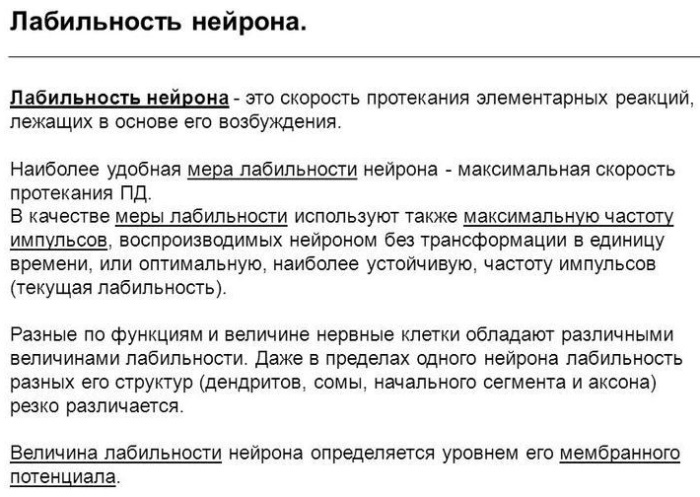
All existing stimuli are usually subdivided into adequate and inadequate, taking into account the factors of biological correspondence of certain stimuli to the properties of sensory receptors.
Nonspecific characteristics of action potential generation are always the result of biochemical and physicochemical processes that occur in tissues. In the scientific environment, electric current is used as the main stimulus to study the properties of an elementary structural unit of all living organisms.
This choice is associated with the following factors:
- The electric current can be calibrated as accurately as possible according to the strength and duration of exposure to living cells.
- When used correctly, electric current does not have a negative effect on the body.
- Electric current is the closest to the natural mechanisms of the onset and subsequent propagation of excitation.
The existing stimuli of the minimum intensity of influence on cells cannot cause a response of the maximum magnitude in the body. That is why such influencing factors are usually called subthreshold. But even in the absence of any external signs of response, complex biochemical processes can occur in the cells, and an improvement in metabolism is possible. The index of all the changes occurring is insufficient to enhance the functions of the cell membrane.
Adequate
The physiological stimulator of sensations, which provokes the selective release of certain receptors, is usually called an adequate factor of influence. Experts have proven that this category includes factors that all living organisms were able to perceive. adapt as a result of changes in living matter during the development of an organism or in a sequence of generations organisms.
At the same time, adequate factors of the external and internal environment are specific to a particular organ. For example, for the ear - a loud sound, for the eyes - a bright light, for the nose - a pungent smell. Physiological stimulants differ significantly from common neural stimuli.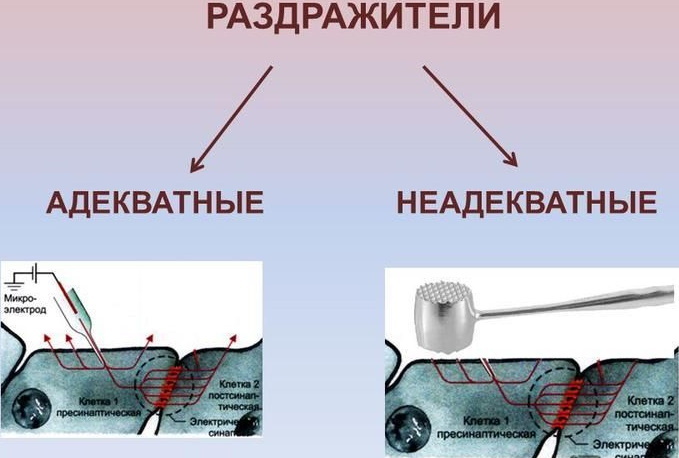
In the course of experiments, it was proved that for light-sensitive sensory neurons and other cells of the visual organ the stimulus is a photon, to which the corresponding reaction is formed in the photoreceptors of the retina upon absorption 3 quanta.
Inadequate
Irritants can be called inadequate in cases where the body has not had time to adapt to certain physiological stimulants. For example, for the muscles of the skeleton, a nerve impulse is an adequate factor of internal influence. But at the same time, excitation can arise under the action of a current or mechanical shock, which is an inadequate stimulus for muscle tissue. Its lowest strength significantly exceeds the indicators of an adequate impact factor.
Basic properties
Lability in physiology is a disorder of the autonomic nervous system, when, under the influence of external factors, various disturbances in the functioning of the body occur. But in practice, the concept of lability is considered equally in physiology and psychology, since this phenomenon reflects a borderline state between them.
Depending on the rate of development of excitation processes, experts distinguish:
- High lability. The response to the stimulus is instantaneous, while the restraining factors (for example, the type of character, the impulse of inhibition, the level of upbringing) do not work.
- Low lability. This type of arousal is considered common among people with a rigid nervous system, since the body's response to external stimuli is minimal.
The main property of tissues is considered irritability, indicating the ability of cells and intercellular substances change their initial characteristics and form a functional response to action stimulus.
Experts managed to determine several general physiological characteristics of living tissues:
- Conductivity. This property is responsible for the ability of the elementary structural units of living organisms to transmit the generated wave excitation, while sending the generated signal from the initial site of stimulus action throughout the excitable site.
- Lability. This value is not constant. As a result of excitation, the tissue reacts to the existing stimulus at a certain speed.
- Refractoriness. Any object of autowave nature may not respond to stimuli if it remains in a specific refractory state. In rare cases, refractoriness may be absolute.
-
Excitability. By changing the initial physiological properties, as well as the emergence of excitation, the aggregate of cells and intercellular substance responds to the action of a prolonged, powerful stimulus.
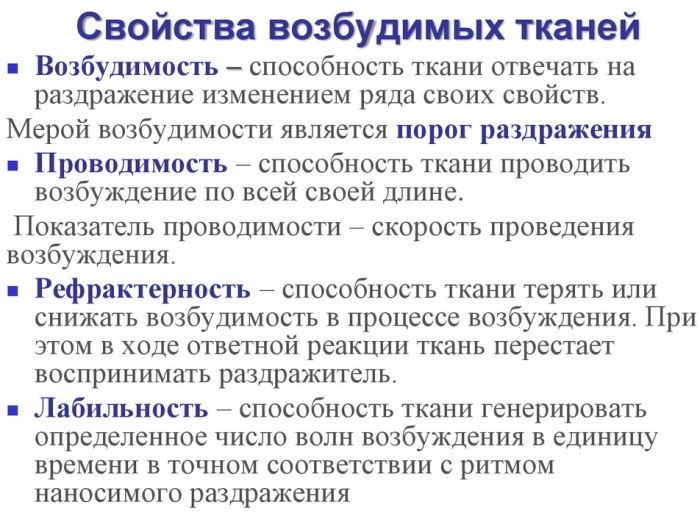
Connective, bone and adipose tissue are non-excitable. Even if they are exposed to an irritant, their cells are not able to form a wave of excitation.
Physiological tissue lability depends on the frequency and strength of excitation impulses coming from the central nervous system. The degree of nervous and humoral influences is also taken into account. Physiologist N. E. Vvedensky proved that there is a relationship between excitability and physiological lability.
The excitability of the tissue reaches its maximum values with an average, relatively low level of physiological lability. But the lability of tissues increases if it takes a minimum of time for the occurrence of excitement during irritation.
Indicators
Lability in physiology is the rate of occurrence of elementary physiological reactions, which determines the functional state of a living substrate. The main indicator of the functional mobility of tissues is the maximum allowable number of excitation waves that can occur in 1 s.
As a result of an increase in the frequency of rhythmic stimulation, the resulting cell lability gradually increases. In 1928 g. Russian, Soviet physiologist A. Ukhtomsky described in detail the ability of tissues to respond with a higher (lower) rhythm of excitation compared to the initial level.
Laboratory studies have shown that the lability of nerve fibers varies within 500 impulses per s. Only in rare cases does this figure reach 1000 impulses or more. Thick myelinated fibers are endowed with the highest lability. Local anesthetics can slow down the reactivation of sodium channels and increase the duration of the phase of relative refractoriness. For example, if nerve fibers are exposed to Novocaine in small doses, then, as a result, the fiber will lose the ability to conduct high-frequency impulses.
When excitation of a rhythmic nature occurs, the functional mobility of tissues can not only decrease, but also increase. A gradual decrease in functional mobility leads to the emergence of inhibition processes. But the increase in lability determines the properties of living cells to adapt to higher rates of impulse, which is due to the excretion of Na + ions from the semi-liquid contents of the cell.
Due to this, muscle fibers can adapt to a more frequent rhythm of impulses that come to them from the long processes of neurocytes. In the form of a local potential, inhibition occurs. The reactions of excitation and subsequent inhibition are closely related, since they occur simultaneously and are participants in the same process. There is an induction relationship between the two.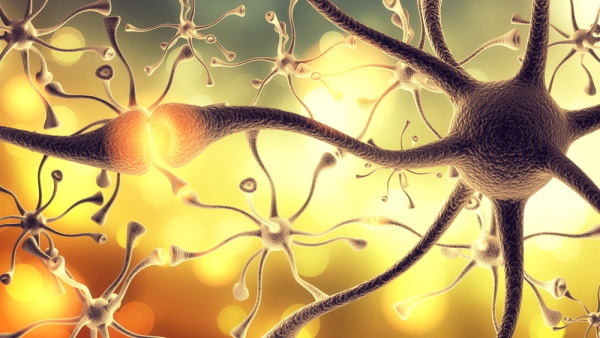
Nervous tissue possesses high indicators of lability, since it can form up to 1000 impulses in 1 s. In muscle tissue, this indicator is reduced by 2 times. In the maximum rhythm of impulses, cells can work for a short period of time. In natural, unchanged conditions, the tissues are able to respond to the arousal that has arisen, but the rhythm will be minimal. In this case, the result is maintained over a long period of time.
How is it measured
A special lability control measure is used to effectively measure the rate at which the full period of a single release pulse arises and ends in cells. But even the resulting indicator is not a constant value, since it can change under exposure to external factors (time of day, high temperature), emotional state and chemical substances.
Experts recommend monitoring only the dynamics. The change in the value of lability is one of the main indicators in the diagnosis of various diseases.
It is lability that describes all changes in the physiological state of living tissue not with a single excitation wave, and when taking into account the totality of successive changes in the electrical state membranes.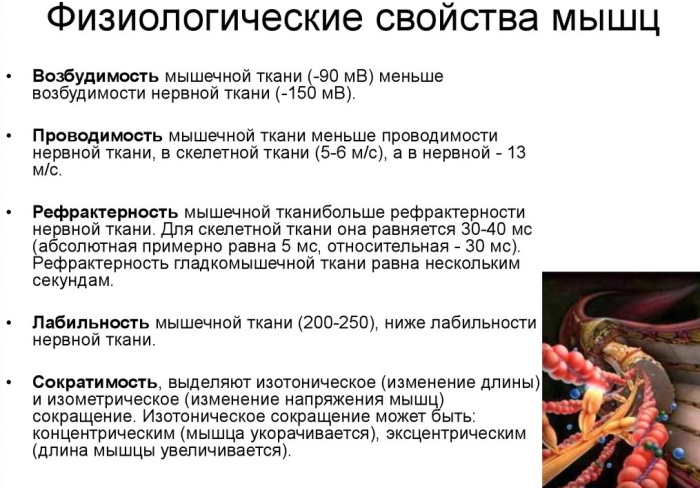
Conditions that reduce cell viability (e.g. excessive heating / cooling, mechanical pressure, chemicals, saline solutions, drugs), reduce the lability of the altered by this effect section of the nerve. This is due to the fact that under the influence of the listed factors, the recovery processes slow down.
Lability video
Lability of fabric:



